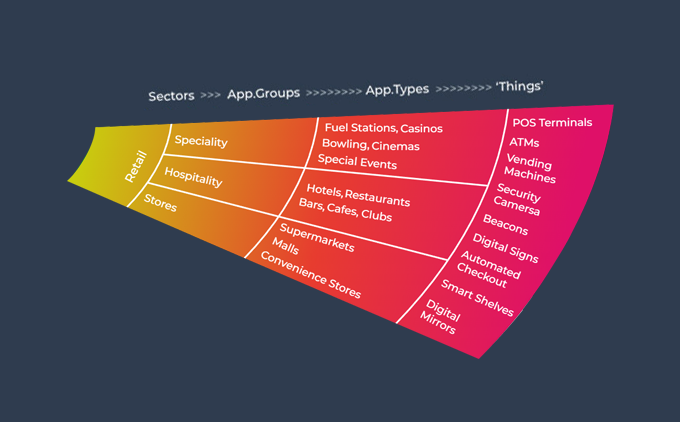The IoT In Retail market size is expected to reach USD 94 billion by 2025 with a CAGR 2019-2025 of 21%. Increased flexibility, diversified distribution channels and increased demand for better service are expected to drive growth. There is also the merging of digital and in-store operations in retail stores – omni-channel shopping in conjunction with fast smartphone adoption by customers.
This is substantial growth in a sector that has been hugely challenged by the COVID pandemic. Key to this is following a customer’s experience from identifying a purchase to shopping and closing a purchase.
- Researching the desired product online. At home, for virtual retailing the look and ease of use of the merchant’s web site allows buyers to get a tangible view of the merchandise through digital screens, virtual mirrors, virtual mannequins and augmented reality.
- Visiting the retail outlet. Parking, navigating and browsing the shopping mall and all its temptations and distractions.
- Arriving at the store, examining the product and paying.
IoT can help both customers and retailers make the purchasing process more exciting, safer and easier. For sellers, systems to manage stock, streamline payment, refill shelves and so on. In addition, customer and retailer data to keep safe, especially payment data.
1. Key Issues in the sector
- Process changes: The 2020-22 pandemic has hit the retail industry hard, with many retail outlets having to close. Online ordering has concomitantly increased. This imposes changes in processes on the part of both customers and retailers and their suppliers, not to mention stricter requirements on data security, privacy, completeness, and accuracy.
- Data quality and accessibility: Today’s world has more connected and interconnected things than ever with data flowing across companies, systems and international boundaries. Retailers in particular have data in a wide range of systems – on-premises and in the Cloud. Ideally, it should be possible to trace where every piece of data resides, where it goes and, if someone wants it changed or removed, how to find it and comply with the request.
- Cyber threats: Theft from data stores has also been escalating since Covid –including ransomware and fraud. According to the 2021 Crowdstrike Global Security Attitude Survey, 69% of respondents experienced a cybersecurity incident as a direct result of teams working remotely. Moreover 77% of respondents experienced a cyberattack in 2020-21, increasing from 66% in 2018.
- Supply chain security: Global Supply chains are getting more complex with many partners in the supply chain – encompassing manufacturers, retailers and delivery systems. Uncertainty in supply chains has also increased due to Covid, and in 2022, political unrest in Europe has exacerbated the situation with consequences worldwide.
2. How IoT is addressing these challenges
- Navigating the Shopping mall: There are many IoT applications to help the customer here. Shopping malls are about connected goods and their buyers and enhancing and facilitating the customer experience. Typically they provide many wireless access points for customer use. Various apps translate into more money from additional food and beverages for vendors.
- Smart parking on arrival: – sensors embedded in the tarmac collect real time information about free spaces for smartphone users to view; this saves motorists driving around searching for a place, generating emissions and wasting fuel.
- Wayfinding and digital signage: Digital signage and smart kiosks are updated in near real time, to help customers find what they need. 3D Wayfinding uses omni channel indoor navigation, plus interfaces for locations, points of interest and services. Interactive map and plans, intelligent signage show entry and exit points, facilities etc.
- Bluetooth Low Energy beacons signal items of interest to passers; compatible mobile phones can receive content when near a BLE beacon. Retailers provide passers-by with product information or notify flash sales.
- Smartphone trackers record the unique signal that each phone sends when it searches for a Wi-Fi network. This information is used to track customers and build a profile around their buying habits.
- Smart vending machines send a message to the vendor when the merchandise needs replenishing.
- Media projection for large spaces can highlight events of interest to passing customers.
- Environmental Sensing measure ambient temperature, air quality for the safety and comfort of customers as well as workers (for example, cooking in a restaurant during a heat wave)
- Smart lighting – daylightsensors to ensure constant light levels using daylight harvesting; ensuring that areas are lit only when and where they are needed.
- Video surveillance. Shopping malls are crowded places. IoT apps include Video surveillance for detecting overcrowded areas. Solutions that employ people-counting sensors can be used to enforce physical distancing. Facial recognition technology can identify suspicious or criminal behaviour.
- Preparedness against terrorism – Shopping malls are potential targets for terrorism. To give just one example, in 2013 masked gunmen attacked a shopping mall in Nairobi, with 71 people killed. There is a need for surveillance, and also readiness to summon emergency help and ensure safe and rapid evacuation of the people. Enabling immediate responses depends on real time data. Transmitting images in real time necessitates high bandwidth communications.
3. Applications using IoT
With 5G, ultra-reliable and low latency communications together with high density connectivity options can support real time needs at the same time as large densities of low data rate connected sensors. As enclosed spaces, shopping malls are then good candidates for private cellular networks.
IoT application examples then include:
- Help for customers:
- Visualisation apps: these use Augmented Reality and Virtual Reality for an immersive customer experience. Digital mirrors or virtual mirrors superimpose a garment onto the customer’s body and automatically adjust the size. The ‘mirror’ can be viewed from any device.
Any technology involving augmented and virtual reality would likely require high bandwidth transmission, due to the size of the packets and the real time / near real time needs of transmission.
- Facilitating payment through connecting with customer smartphones:
- Automated checkout
- POS transactions and device agnostic connected payment solutions
- Cashless and cashier-less payment systems
- Secure ATM with video.
- Visualisation apps: these use Augmented Reality and Virtual Reality for an immersive customer experience. Digital mirrors or virtual mirrors superimpose a garment onto the customer’s body and automatically adjust the size. The ‘mirror’ can be viewed from any device.
- Help for retailers:
- Tracking of onsite equipment, for example trolleys to ensure they do not leave the store and are available to customers.
- Vision Systems incorporating artificial intelligence are used for facial recognition to categorise a shopper according to age and gender, for generally targeted promotions.
- Real time inventory control for managing and updating stock levels.
- Electronic shelf labels (ESL) – for supermarkets and department stores. These use liquid-crystal displays to show the current product’s price to the customer; the price display is automatically updated whenever a price is changed.
- Retail in-store monitoring of consumer goods, where a wide range of data is collected through multiple technologies; this allows retailers to analyse the data to discover buying patterns, preferences and other attributes – to help them develop effective marketing programmes.
4. How the IoT World Map can assist
IoT solutions have several different elements and can be complex. This complexity will also increase with more use of real time processing, the introduction of private networking and the rollout of 5G. Each of these offers major benefits in this sector but assistance from IoT solution experts with specific knowledge of the retail sector is increasingly needed. This presents a difficulty for IoT buyers, who typically have to identify which suppliers have specific knowledge of their application areas.
The IoT World Map is arranged so that those requiring IoT solutions can access the map knowing only the applications they need support for in their own sector. IoT suppliers who have direct retail sector experience and can assist specifically in such solutions can be readily identified and contacted.
The aim of this is to assist IoT buyers to proceed more quickly to solution design and implementation.
Robin Duke-Woolley
Beecham Research










